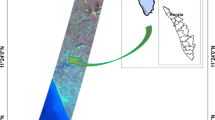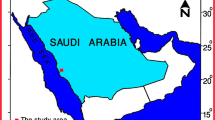Abstract
SVM and SAM classifiers for the lithological mapping using Hyperion data in parts of Gadag schist belt of western Dharwar craton, Karnataka, India were used. The main objective of the present study is to assess and compare the potential use of Hyperion data set for lithological mapping. Accuracy assessment of the derived thematic maps was based on the analysis of the confusion matrix statistics computed for each classification map. For consistency, the same set of validation points were used in evaluating the accuracy of the lithological thematic maps produced. On the basis of the accuracy assessment results, it appears that SVM generally outperformed the SAM classifier in both OA accuracy and individual classes’ accuracies. OA accuracy and Kc for SVM is 96.93% and 0.9655, whereas for SAM it is 74.02% and 0.7085 respectively. SVM classification is the best in describing the spatial distribution and the cover density of each lithology, as was also indicated from the statistics of the individual class results. The individual class accuracy were also analyzed for the SVM and the result show that PA ranges from 87% to 100% and UA ranges from 91% to 100%, whereas for SAM ranges from 15% to 95%, and from 31% to 100% respectively. The SVM method could effectively classify and improve on the existing geological map for the Gadag schist belt (GSB) using hyperspectral data. The results could be validated through field visits. Therefore, it is concluded that hyperspectral remote sensing data can be efficiently used to improve existing maps, especially in areas where same rock types show variable degree of alteration over smaller spatial scales.
Similar content being viewed by others
References
Archana Joshi Tanushri, Swetha, M. and Mandla, V. R. (2013) Mapping of identification of red-sandalwood using hyperspectral. Internat. Jour. Appld. Engg. Res., v.8(19), pp.2471–2474.
Beck, Dr.Richard (2003) EO-1 User Guide, Version 2.3.
Beeraiah, M.B. and Sengupta S. (1998) A report on the investigation for gold in Malasamudra north block, Gadag schist belt, Dharwar district, Karnataka.
Bhattacharya S., Majumdar, T.J., Rajawat, A.S., Panigrahi, M.K. and Das, P.R. (2012) Utilization of Hyperion data over Dongargarh, India, for mapping altered/weathered and clay minerals along with field spectral measurements. Internat. Jour. Remote Sensing, v.33(17), pp.5438–5450
Chakrabarti, D., Mallic, T.C., Pyne, T.K. and Guha, D. (2006) A Manual of the geology of the India, volume I: Precambrian, part I -Southern part of the Peninsula. Geol. Surv. India (check), Spec. Publ., No.77, 4th edition.
Coll, C., Caselles, V., Valor, E., Niclos, R., Sanchez, J.M., Galve, J.M. and Mira, M. (2007) Temperature and emissivity separation from ASTER data for low spectral contrast surfaces. Remote Sensing Environ., v.110, pp.162–175.
Dadon Alon, Ben-Dor Eyal, Beyth Michael and Karnieli Arnon (2011) Examination of spaceborne imaging spectroscopy data utility for stratigraphic and lithologic mapping. Jour. Appld. Remote Sensing, v.5, pp.1–15.
Deb, M. (2014) Precambrian geodynamics and metallogeny of the Indian shield. Ore Geol. Rev., v.57, pp.1–28.
Glorie, S., Grave, J. De, Singh, T., Payne, J.L. and Collins, A.S. (2014) Crustal root of the Eastern Dharwar Craton: U-Pb age and Lu-Hf isotopic evolution of the East Salem Block, southeast India. Precambrian Res., v.249, pp.229–246.
Green, A. A., Berman, M., Switzer, P. and Craig, M. D. (1988) A transformation for ordering multispectral data in terms of image quality with implications for noise removal. IEEE Trans. Geosci. Remote Sensing, v.26(1), pp.65–74.
Hasan, R., Ierodiaconou, D. and Monk, J. (2012) Evaluation of Four Supervised Learning Methods for Benthic Habitat Mapping Using Backscatter from Multi-Beam Sonar. Remote Sensing, v.4, pp.3427–3443.
Hewson, R.D., Cudahy, T.J., Mizuhiko, S., Ueda, K. and Mauger, A.J. (2005) Seamless geological map generation using ASTER in the Broken Hill-Curnamona province of Australia. Remote Sensing Environ., v.99, pp.159–172.
Kusuma, K. N., Ramakrishnan, D. and Pandalai, H.S. (2012) Spectral pathways for effective delineation of high-grade bauxites: a case study from the Savitri River Basin, Maharashtra, India, using EO-1 Hyperion data. Internat. Jour. Remote Sensing, v.33(22), pp.7273–7290.
Mountrakis, G., Im, J. and Ogole, C. (2011) Support vector machines in remote sensing: A review. ISPRS Jour. Photogrammetry and Remote Sensing, v.66, pp.247–259.
Narayanaswamy, S. and Ahmed, M. (1963) Geology of Gadag Gold field, Dharwar District, Mysore State. Mem. Geol. Soc. India, no.1, pp.107–116.
Petropoulos George, P., Arvanitis Kostas, Sigrimis Nick, (2012) Hyperion hyperspectral imagery analysis combined with machine learning classiûers for land use/cover mapping. Expert Systems with Applications v.39, pp.3800–3809
Ramakrishnan, D., Nithya, M., Singh, K.D. and Bharti, R. (2013) A field technique for rapid lithological discrimination and ore mineral identification: results from Mamandur polymetal deposit, India. Jour. Earth Syst. Sci., v.122(1), pp.1–14.
Rani, N., Ravibabu Mandala, V. and Singh, T. (2016a) Spatial distribution of altered minerals in the Gadag Schist Belt (GSB) of Karnataka, Southern India using Hyperspectral Remote Sensing data. Geocarto International. doi:10.1080/10106049.2015.1132484
Rani, N., Ravibabu Mandala, V. and Singh, T. (2016b) Evaluation of atmospheric correction on hyperspectral data with special reference to mineral mapping. Geoscience Frontiers. doi:10.1016/j.gsf.2016.06.004.
Teja Kondraju, T., Mandla, V.R.B., Mahendra, R.S. and Kumar, T.S. (2014) Evaluation of various image classification techniques on Landsat to identify coral reefs Geomatics, Natural Hazards and Risk, v.5(2), pp.173–184. doi: 10.1080/19475705.2013.802748
Tommaso, I. D. and Rubinstein, N. (2007) Hydrothermal alteration mapping using ASTER data in the Infiernillo porphyry deposit, Argentina. Ore Geol. Rev., v.32, pp.275–290.
Zhang Xianfeng and Pazner Micha (2007) Comparison of lithologic mapping with ASTER, Hyperion, and ETM Data in the Southeastern Chocolate Mountains, USA. Photogrammetric Engineering & Remote Sensing, v.73(5), pp.555–561.
Author information
Authors and Affiliations
Corresponding author
Rights and permissions
About this article
Cite this article
Rani, N., Mandla, V.R. & Singh, T. Performance of image classification on hyperspectral imagery for lithological mapping. J Geol Soc India 88, 440–448 (2016). https://doi.org/10.1007/s12594-016-0507-5
Received:
Accepted:
Published:
Issue Date:
DOI: https://doi.org/10.1007/s12594-016-0507-5




